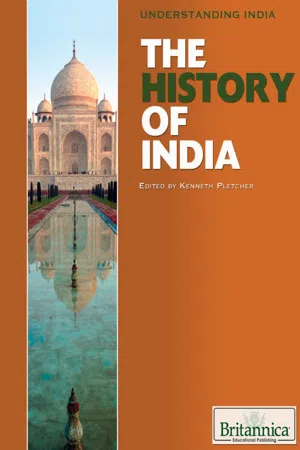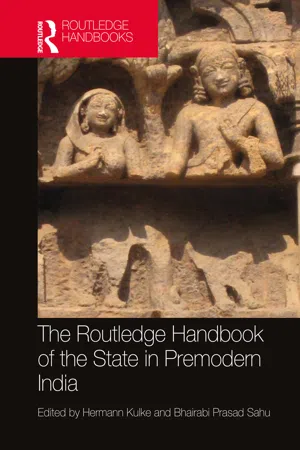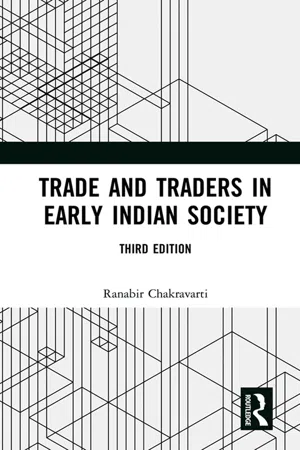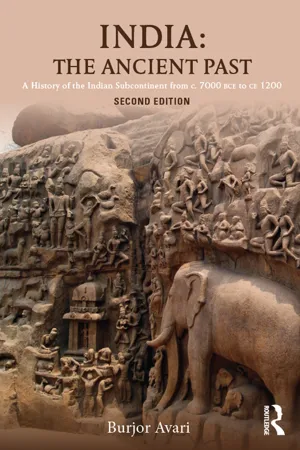History
Medieval India
Medieval India refers to the period between the 8th and 18th centuries, characterized by the rise and fall of various dynasties and empires. This era saw significant developments in art, architecture, literature, and trade, as well as the introduction of Islam to the Indian subcontinent. It was a time of cultural exchange, political upheaval, and the flourishing of diverse traditions.
Written by Perlego with AI-assistance
Related key terms
4 Key excerpts on "Medieval India"
- eBook - ePub
- Britannica Educational Publishing, Kenneth Pletcher(Authors)
- 2010(Publication Date)
- Britannica Educational Publishing(Publisher)
HE DEVELOPMENT OF INDIAN CIVILIZATION FROM C . 1500 BCE TO 300 CET he gradual decline of the Indus civilization marks the beginning of the transition, over the span of roughly 1,800 years, from prehistoric to historic times. Among many remarkable developments, the period is notable for the rise and fall of vast and small states (notably the Mauryan empire), the further spread of Indo-Aryan speakers and, later, the invasion of Alexander the Great, the emergence of great religions, and remarkable achievements in literature and the arts.TRADITIONAL APPROACHES TO INDIAN HISTORIOGRAPHY
The European scholars who reconstructed early Indian history in the 19th century regarded it as essentially static and Indian society as concerned only with things spiritual. Indologists, such as the German Max Müller, relied heavily on the Sanskritic tradition and saw Indian society as an idyllic village culture emphasizing qualities of passivity, meditation, and otherworldliness. In sharp contrast was the approach of the Scottish historian James Mill and the Utilitarians, who condemned Indian culture as irrational and inimical to human progress. Mill first formulated a periodization of Indian history into Hindu, Muslim, and British periods, a scheme that, while still commonly used, is now controversial. During the 19th century, direct contact with Indian institutions through administration, together with the utilization of new evidence from recently deciphered inscriptions, numismatics, and local archives, provided fresh insights. Nationalist Indian historians of the early 20th century tended to exaggerate the glory of the past but nevertheless introduced controversy into historical interpretation, which in turn resulted in more precise studies of Indian institutions. In more recent times, historians have reconstructed in greater detail the social, economic, and cultural history of the subcontinent—though politics has continued to influence the study of Indian history. - Hermann Kulke, Bhairabi Prasad Sahu, Hermann Kulke, Bhairabi Prasad Sahu(Authors)
- 2022(Publication Date)
- Routledge India(Publisher)
Political Systems: Integrative Processes and States in Pre-modern India (Sahu and Kulke 2015). It was the major intention of this volume to highlight integrative processes of premodern (and in particular of early medieval) state formation. The basic concern of the new volume is to scale down the usual urge to define ‘the Indian state’. Instead it accentuates the great variety and abundance of aspects which not only influenced but also accompanied processes of state formation in India, but which so far have not mostly received the necessary attention in such studies. The proposed volume tries to address some of these issues. Briefly stated, the articles of the first two sections, ‘Political systems in practice’ and ‘Early medieval polities’, emphasize, e.g., the importance of autonomous spaces and forests, maritime trade, royal patronage and monumental temple architecture and courtly manners, violence and regional elites. The two final sections similarly raise and address a number of new questions. ‘Into the medieval’ points out the important role of local and subregional historiography for validation of power and kingship ideology, and the Islamic influences on Puranic Hindu dominated processes and ideologies of state formation. Finally, ‘Beyond the premodern’ emphasizes the survival and bearing of premodern structures and ideologies in early modern and contemporary local and subregional socio-political systems of India.To elaborate, there has been a visible shift towards addressing issues ranging from the complex social milieu of political systems, communication networks and modes of signaling intent of people in authority to transformations from clan-based to state societies, perspectives from texts and ‘invented histories’. Noticeably much of these writings in their efforts to delineate the political processes at play have moved beyond the entrenched concepts and refrained from labeling them within familiar, but debatable, categories. It is no coincidence that the collection of essays in two more recently published festschrift volumes in honor of two leading historians of India – Romila Thapar and B. D. Chattopadhyaya – effectively showcase the mood of the times (Roy and Dayal 2019; Bopearachchi and Ghosh 2019).The twenty-seven chapters chronologically cover Indian history from the mid-first millennium BCE to the eighteenth century AD, and spatially the major regions of South Asia. The Introduction is divided into five sections: (1) the basic preliminaries, (2) concepts of state and state formation in early Medieval India: state-of-the-art, (3) the state in Medieval India and beyond: issues and debates, (4) states in activity, and, finally, (5) interdisciplinary studies, political validation and societal consent. The arguments of the constituent essays in the volume will be interwoven into the relevant sections of the Introduction, instead of being routinely summarized at the end.- eBook - ePub
- Ranabir Chakravarti(Author)
- 2020(Publication Date)
- Routledge(Publisher)
c. 600 BC -AD 300)Researches in early Indian history over the last three decades show a major change in historical vision: the earlier emphasis on dynastic chronicling is increasingly being replaced by the historian’s penchant for understanding the economy, society, polity and culture of early India. Historians appear now to have been less interested in what Kosambi termed as ‘episodic history’1 and engage themselves in unravelling the changing character of early Indian history and also identifying the possible agents of such changes. One such formative stage of Indian history is termed ‘early historical’ which spans from sixth century BC to third century AD and which succeeds the proto-historic/pre-literate phase in the history of the subcontinent.The period witnessed the rise of territorial powers (janapadas/mahājanapadas) in place of lineage-based polities (janas); it also saw a continuous struggle between the urge for imperial unity and the love for local autonomy (expressed mainly by the ‘republican’/oligarchic or gaṇa-samgha type of polities).2 The most important change in the economic life was the emergence of agriculture as the mainstay of the material life of the people first in the Ganga valley and then gradually over the whole of the subcontinent. The agrarian economy when firmly rooted naturally provided enough surplus to maintain whole-time craftsmen of diverse types. As production increased both in the spheres of agriculture and crafts, trade developed in a natural sequence. The early centuries df the Christian era ushered in a glorious phase of Indian commerce which was drawn into the network of international trade, both overland and maritime. The new generative forces must have helped in transforming an essentially lineage-based and more or less egalitarian society into a stratified society. Symptoms of a complex society are discernible in the form of sharpening of varṇa-jāti - eBook - ePub
India: The Ancient Past
A History of the Indian Subcontinent from c. 7000 BCE to CE 1200
- Burjor Avari(Author)
- 2016(Publication Date)
- Routledge(Publisher)
et al. 2000: 443–4). However, there can be no doubt that both religious and secular land grants during these early medieval centuries provided a major boost to the growth of feudalism and a feudal mentality in north India.The debate on feudalismDespite various dissenting views among historians, the inscriptions of the period provide strong evidence of the way feudalism linked the states with their economies. Feudalism would long remain a persistent factor in the shaping of Indian society and its mindset, although its characteristics would undergo much transformation in succeeding centuries. Karl Marx described feudalism as the pre-capitalist stage of development in the social and economic history of Europe. It was a stage in which the mode of agricultural production was based on the relationship between the lord and the peasantry. In this relationship the peasants owed the lord labour service for being allowed to till the soil and eke out a subsistence living. They also had to accept extensive judicial powers over their lives as a measure of protection by the lord. Historians have also debated over feudalism as a method of maintaining order at a time, particularly between the tenth and the fourteenth centuries in Western Europe, when public institutions were in a state of crisis and flux. In that situation, private relationships had become crucial, and one of the key manifestations of this relationship was the arrangement by which a tributary lord attached himself to a liege lord for protection through homage, tribute and military service.Excerpt 9.2 A land grant in BengalThousands of land grants have been found recorded on copper plates all across India. It was an old tradition, but the bulk of the evidence comes from the Gupta and post-Gupta centuries. The inscriptions are engraved on one or more plates of copper varying in size, between 6 and 20 inches long. The plates were prepared with great care in order to protect the writing from damage or wear and tear. Often the edges were raised to prevent the plates from rubbing together, and sometimes the outer plates or faces were left blank. Multiple plates were bound by one or two rings inserted through holes in the plates. As many as a dozen plates could be found joined, carrying as much as 200 pounds of weight. A typical inscription had a preamble that included an invocation, the place of issue, the grantor’s name and ancestry, address. This was followed by the specification of the gift, names of the grantee(s), the purpose of the grant and the reason for it. There would be a word or two of exhortation to respect the grantor’s command. The names of people witnessing the grant would also be recorded. The following partial extract is a typical example
Index pages curate the most relevant extracts from our library of academic textbooks. They’ve been created using an in-house natural language model (NLM), each adding context and meaning to key research topics.



